Snapper SZT18386BVE, SZT18336BVE User Manual
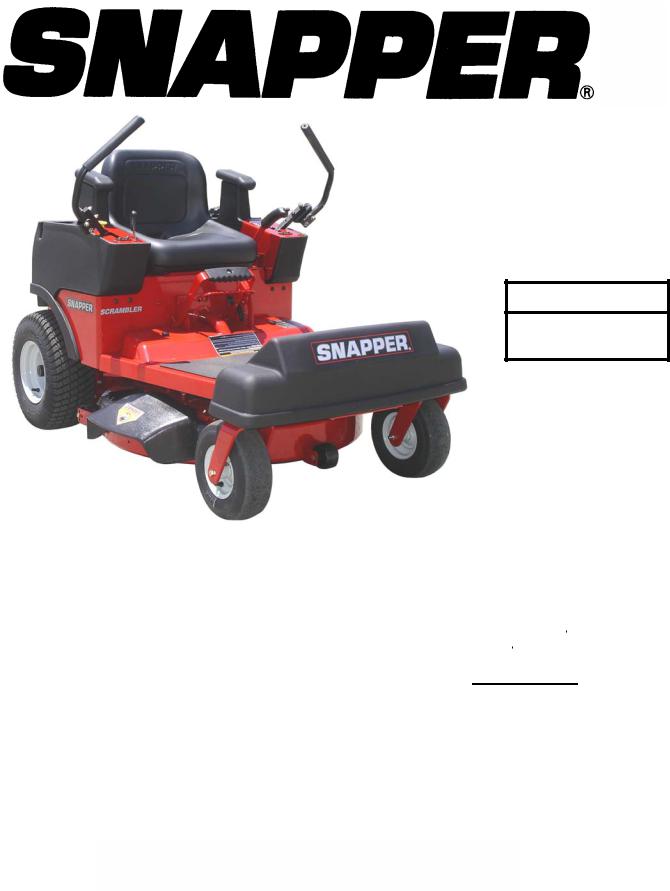
Safety Instructions & Operator’s Manual for
SCRAMBLER
ZERO-TURN
HYDRO DRIVE
SERIES 6
MODELS
SZT18336BVE
SZT18386BVE
|
|
|
|
|
|
|
|
|
MODEL NUMBER EXPLANATION |
|
|
|
|
|
|
|
|
|
|
|
||||||||||||
|
|
|
|
|
|
|
|
|
|
|
|
|
|
|
|
|
|
|
|
|
|
|
|
|
|
|
|
|
|
|
|
|
|
|
|
|
S |
Z |
|
T |
18 |
|
33 |
6 |
|
B |
V |
|
E |
|
|
|
|||||||||||||
MODEL DESIGNATION |
|
|
|
|
|
|
|
|
|
|
|
|
|
|
|
|
|
|
|
|
|
|
|
|
ENGINE OPTIONS |
|||||||
|
|
|
|
|
|
|
|
|
|
|
|
|
|
|
|
|
|
|
|
|
|
|
|
|||||||||
|
|
|
|
|
|
|
|
|
|
|
|
|
|
|
|
|
|
|
|
|
|
|
|
|||||||||
DRIVE SYSTEM TYPE |
|
|
|
|
|
|
|
|
|
|
|
|
|
|
|
|
|
|
|
|
|
|
|
|
|
ENGINE TYPE |
||||||
|
|
|
|
|
|
|
|
|
|
|
|
|
|
|
|
|
|
|
|
|
|
|
|
|
||||||||
ENGINE HORSE POWER * |
|
|
|
|
|
|
|
|
|
|
|
|
|
|
|
|
|
|
|
|
SERIES DESIGNATION |
|||||||||||
|
|
|
|
|
|
|
|
|
|
|
|
|
|
|
|
|
|
|
|
|||||||||||||
CUTTING WIDTH |
|
|
|
|
|
|
|
|
|
|
|
|
|
|
|
|
|
|
|
|
|
|
|
B - Briggs Engine |
|
|||||||
|
|
|
|
|
|
|
|
|
|
|
|
|
|
|
|
|
|
|
|
|
|
|
|
|
||||||||
S – Scrambler |
|
18 – 18.0 HP Engine |
|
33 - 33” Cutting Deck |
|
|
6 - Series Designation |
E - Electric Start |
||||||||||||||||||||||||
ZT – Zero Turn |
|
|
|
|
|
|
|
|
|
38 - 38” Cutting Deck |
|
|
|
|
|
|
|
|
V – Over Head Valve |
|
||||||||||||
|
|
|
|
|
|
|
|
|
|
|
|
|
|
|
|
|
|
|
|
|
|
|
|
|
|
|
|
|
|
|
|
|
|
|
|
|
|
|
|
|
|
|
|
|
|
|
|
|
|
|
|
|
|
|
|
|
|
|
|
|
|
|
|
|
|
Thank you for buying a SNAPPER Product! Before operating your SCRAMBLER, read this manual carefully and pay particular attention to the “IMPORTANT SAFETY INSTRUCTIONS” on Pages 2 - 4. Remember that all power equipment can be dangerous if used improperly. Also keep in mind that SAFETY requires careful use in accordance with the operating instructions and common sense!
NOTE: Specifications are correct at time of printing and are subject to change without notice.
* Actual sustained equipment horsepower will likely be lower due to operating limitations and environmental factors.
COPYRIGHT © 2004
SNAPPER – A DIVISION OF SIMPLICITY MFG. INC.
ALL RIGHTS RESERVED
MANUAL No. 5-0407 (I.R. 7/27/04)

IMPORTANT SAFETY INSTRUCTIONS
WARNING: This powerful cutting machine is capable of amputating hands and feet and can throw objects that can cause injury and damage! Failure to comply with the following SAFETY instructions could result in serious injury or death to the operator or other persons. The owner of the machine must understand these instructions and must allow only persons who understand these instructions to operate machine. Each person operating the machine must be of sound mind and body and must not be under the influence of any substance, which might impair vision, dexterity or judgment. If you have any questions pertaining to your machine which your dealer cannot answer to your satisfaction, call or write the Customer Service Department at SNAPPER, McDonough, Georgia 30253. Phone: (1-800-935-2967).
PROTECTION FOR CHILDREN
Tragic accidents can occur if the operator is not alert to the presence of children. Children are often attracted to the machine and the mowing activity. Children who have been given rides in the past may suddenly appear in the mowing area for another ride and be run over or backed over by the machine. Never assume that children will remain where you last saw them.
1.KEEP children out of the mowing area and under the watchful care of a responsible adult other than the operator.
2.DO NOT allow children in yard when machine is operated (even with the blade OFF).
3.DO NOT allow children or others to ride on machine, attachments or towed equipment (even with the blades OFF). They may fall and be seriously injured.
4.DO NOT allow pre-teenage children to operate machine.
5.ALLOW only responsible adults & teenagers with mature judgment under close adult supervision to operate machine.
PROTECTION AGAINST TIPOVERS
(Continued From Previous Column)
5.STAY ALERT for holes and other hidden hazards. Tall grass can hide obstacles. Keep away from ditches, washouts, culverts, fences and protruding objects.
6.KEEP A SAFE DISTANCE (at least 3 feet) away from edge of ditches and other drop offs. The machine could turn over if an edge caves in.
7.Always begin forward motion slowly and with caution.
8.Use weights or a weighted load carrier in accordance with instructions supplied with a grass catcher. DO NOT operate machine on slopes exceeding 10 degrees (18% grade) when equipped with grass catcher.
9.DO NOT put your foot on the ground to try to stabilize the machine.
10.DO NOT operate machine on wet grass. Reduced traction could cause sliding.
11.Chose a low enough speed setting so that you will not have to stop or shift on a slope. Tires may lose traction on slopes even though the brakes are functioning properly.
6.DO NOT operate blades in reverse. STOP BLADES. 12. DO NOT operate machine under any condition where
LOOK and SEE behind and down for children, pets and hazards before and while backing.
7.USE EXTRA CARE when approaching blind corners, shrubs, trees, or other objects that may obscure vision.
traction, steering or stability is doubtful.
13.Always keep the machine in gear when going down slopes. DO NOT shift to neutral (or actuate hydro roll release) and coast downhill.
PROTECTION AGAINST TIPOVERS
Slopes are a major factor related to loss-of-control and tipover accidents, which can result in severe injury or death. All slopes require extra CAUTION. If you cannot back up the slope or if you feel uneasy on the slope, DO NOT mow it. Use extra care with grass catchers or other attachments; these affect the handling and the stability of the machine.
PREPARATION
1.Read, understand, and follow instructions and warnings in this manual and on the machine, engine and attachments. Know the controls and the proper use of the machine before starting.
2.Only mature, responsible persons shall operate the machine and only after proper instruction.
1.DO NOT operate machine on slopes exceeding 15 3. Data indicates that operators age 60 and above, are
degrees (27% grade).
2.Exercise EXTREME CAUTION on slopes above 10 degrees (18% grade). Turn blades OFF when traveling uphill. Use a slow speed and avoid sudden or sharp turns.
3.DO NOT operate machine back and forth across face of slopes. Operate up and down. Practice on slopes with blades off.
4.AVOID starting, stopping or turning on slopes. If machine stops going uphill or tires lose traction, turn blades OFF and back slowly straight down the slope.
involved in a large percentage of mower-related injuries. These operators should evaluate their ability to operate the mower safely enough to protect themselves and others from serious injury.
4.Handle fuel with extra care. Fuels are flammable and vapors are explosive. Use only an approved fuel container. DO NOT remove fuel cap or add fuel with engine running. Add fuel outdoors only with engine stopped and cool. Clean spilled fuel from machine. DO NOT smoke.
5.Practice operation of machine with BLADES OFF to learn controls and develop skills.
2

IMPORTANT SAFETY INSTRUCTIONS
PREPARATION
(Continued From Previous Page)
6.Check the area to be mowed and remove all objects such as toys, wire, rocks, limbs and other objects that could cause injury if thrown by blade or interfere with mowing.
7.Keep people and pets out of mowing area. Immediately STOP blades, STOP engine, and STOP machine if anyone enters the area.
8.Check shields, deflectors, switches, blade controls and other safety devices frequently for proper operation and location.
9.Make sure all safety decals are clearly legible. Replace if damaged.
10.Protect yourself when mowing and wear safety glasses, long pants and substantial footwear.
11.Know how to STOP blades and engine quickly in preparation for emergencies.
12.Use extra care when loading or unloading the machine into a trailer or truck.
13.Check grass catcher components frequently for signs of wear or deterioration and replace as needed to prevent injury from thrown objects going through weak or worn spots.
SAFE HANDLING OF GASOLINE
To avoid personal injury or property damage, use extreme care in handling gasoline. Gasoline is extremely flammable and the vapors are explosive
1.Extinguish all cigarettes, cigars, pipes and other sources of ignition.
2.Use only an approved fuel container.
3.DO NOT remove fuel cap or add fuel with the engine running. Allow the engine to cool before refueling.
4.DO NOT refuel the machine indoors.
5.DO NOT store the machine or fuel container inside where there is an open flame, spark or pilot light such as on a water heater or other appliances.
6.DO NOT fill fuel containers inside a vehicle or on a truck or trailer bed with a plastic liner. Always place the containers on the ground away from the vehicle before filling.
7.Remove gas-powered equipment from the vehicle or trailer and refuel it on the ground. If this is not possible, then refuel equipment using a portable container, rather than a gasoline dispenser nozzle.
8.DO NOT start gas powered equipment in enclosed vehicles or trailers.
9.Keep the nozzle in contact with the rim of the fuel tank or container opening at all times until fueling is complete. DO NOT use a nozzle lockopen device
10.If fuel is spilled on clothing, change clothing immediately.
11.Never overfill a fuel tank. Replace fuel cap and tighten securely.
OPERATION
1.Mount and dismount machine from left side. Keep clear of discharge opening at all times.
2.Start engine from operator's seat, if possible. Make sure blades are OFF and parking brake is set.
3.DO NOT leave machine with engine running. STOP engine, STOP blades, SET brake, and Remove key before leaving operators position of any reason.
4.DO NOT operate machine unless properly seated with feet on feet rests or pedal(s).
5.STOP BLADES and ENGINE and make sure blades have stopped before removing grass catcher or unclogging mower to prevent loss of fingers or hand.
6.Blades must be OFF except when cutting grass. Set blades in highest position when mowing over rough ground.
7.Keep hands and feet away from rotating blades underneath deck. DO NOT place foot on ground while BLADES are ON or machine is in motion.
8.DO NOT operate machine without entire grass catcher or guards in place and working. DO NOT point discharge at people, passing cars, windows or doors.
9.Slow down before turning.
10.Watch out for traffic when near or crossing roadways.
11.STOP engine immediately after striking an obstruction. Inspect machine and repair damage before resuming operation.
12.Operate machine only in daylight or with good artificial light.
13.Move joystick (if equipped) SLOWLY to maintain control during speed and directional changes.
14.Exercise CAUTION when pulling loads. Limit loads to those you can safely control and attach loads to hitch plate as specified with SNAPPER attachment instructions.
15.On slopes, the weight of the towed equipment may cause loss of traction and loss of control. When towing, travel slowly and allow extra distance to stop.
16.DO NOT operate engine in enclosed areas. Engine exhaust gases contain carbon monoxide, a deadly poison.
17.DO NOT discharge material against a wall or obstruction. Material may ricochet back towards the operator.
18.Only use accessories approved by the manufacturer. See manufacturer’s instructions for proper operation and installation of accessories.
3

IMPORTANT SAFETY INSTRUCTIONS
TOWING
1.Tow only with a machine that has a hitch designed for towing. DO NOT attach towed equipment except at the hitch point.
2.Follow the manufacturer’s recommendation for weight limits for towed equipment and towing on slopes.
3.DO NOT allow children or others on towed equipment.
4.On slopes, the weight of the towed equipment may cause loss of traction and loss of control.
5.Travel slowly and allow extra distance to stop.
MAINTENANCE
1.DO NOT store machine or fuel container inside where fumes may reach an open flame, spark or pilot light such as in a water heater, furnace, clothes dryer or other gas appliance. Allow engine to cool before storing machine in an enclosure. Store fuel container out of the reach of children in a well ventilated, unoccupied building.
2.Keep engine free of grass, leaves or excess grease to reduce fire hazard and engine overheating.
3.When draining fuel tank, drain fuel into an approved container outdoors and away from open flame.
4.Check brakes frequently; adjust, repair or replace as needed.
5.Keep all bolts, nuts and screws properly tight. Check that all cotter pins are in proper position.
6.Always provide adequate ventilation when running engine. Exhaust gases contain carbon monoxide, an odorless and deadly poison.
7.Disconnect negative (black) cable from battery before performing maintenance or service. Cranking engine could cause injury.
8.DO NOT work under machine without safety blocks.
9.Service engine and make adjustments only when engine is stopped. Remove spark plug wire(s) from spark plug(s) and secure wire(s) away from spark plug(s).
10.DO NOT change engine governor speed settings or overspeed engine.
11.Lubricate machine at intervals specified in manual to prevent controls from binding.
12.Mower blades are sharp and can cut. Wrap the blades or wear heavy leather gloves and use CAUTION when handling them.
13.DO NOT test for spark by grounding spark plug next to spark plug hole; spark plug could ignite gas exiting engine.
14.Have machine serviced by an authorized SNAPPER dealer at least once a year and have the dealer install any new safety devices.
MAINTENANCE
(Continued From Previous Column)
15.Maintain or replace safety and instruction labels as necessary.
16.Use only genuine SNAPPER replacement parts to assure that original standards are maintained.
4
TABLE OF CONTENTS |
|
IMPORTANT SAFETY INSTRUCTIONS........................................................................ |
2-4 |
TABLE OF CONTENTS...................................................................................................... |
5 |
SECTION 1 - FAMILIARIZATION................................................................................... |
6-7 |
SECTION 2 - OPERATING INSTRUCTIONS............................................................... |
8-12 |
Pre-Start Checklist .............................................................................................. |
8 |
Engine Operation.................................................................................................. |
8 |
Motion Control ................................................................................................ |
9-10 |
Mower Operation ................................................................................................ |
11 |
Safety Interlock System Checks ....................................................................... |
12 |
SECTION 3 - MAINTENANCE INSTRUCTIONS ...................................................... |
13-17 |
Service - After First 5 Hours........................................................................ |
13-14 |
Change Engine Oil .......................................................................................... |
13 |
Check Mower Blade ........................................................................................ |
13 |
Check Mower Drive Belt ................................................................................. |
14 |
Check Transaxle Drive Belts.......................................................................... |
14 |
Service - Every 25 Operating Hours ........................................................... |
15-16 |
Check Engine............................................................................................. |
14-15 |
Check Mower Components............................................................................ |
15 |
Lubrication................................................................................................. |
15-16 |
Service – Annually.............................................................................................. |
17 |
Engine .............................................................................................................. |
17 |
Air Filter............................................................................................................ |
17 |
Oil Filter............................................................................................................ |
17 |
Engine Oil......................................................................................................... |
17 |
Transaxle.......................................................................................................... |
17 |
Fuel Filter ......................................................................................................... |
17 |
Storage - Out of Season .................................................................................... |
17 |
SECTION 4 - ADJUSTMENTS AND REPAIR............................................................ |
18-26 |
Motion Control Adjustments ....................................................................... |
18-19 |
Engine Adjustments & Repair........................................................................... |
19 |
Mower Deck & Component Adjustments................................................... |
19-24 |
Mower Drive Belt Adjustment ........................................................................ |
19 |
Mower Drive Belt Removal & Replacement............................................ |
19-20 |
Blade Brake Adjustment................................................................................. |
20 |
Checking Mower Blade Straightness...................................................... |
20-21 |
Mower Deck Adjustment (Levelness) Side to Side...................................... |
22 |
Mower Deck Adjustment (Levelness) Front to Rear ................................... |
23 |
Mower Deck Timing Rod ................................................................................ |
23 |
Wheel Brake Adjustment ................................................................................... |
24 |
Mower Blade Replacement.......................................................................... |
24-25 |
Blade Wear Limits ........................................................................................... |
24 |
Blade Sharpening............................................................................................ |
24 |
Blade Replacement ......................................................................................... |
25 |
Battery ........................................................................................................... |
25-26 |
Battery Removal.............................................................................................. |
25 |
Battery Installation.......................................................................................... |
25 |
Battery Service & Charging............................................................................ |
25 |
Battery Storage................................................................................................ |
25 |
Battery Testing ................................................................................................ |
26 |
New Battery Preparation ................................................................................ |
26 |
TROUBLESHOOTING................................................................................................ |
27-28 |
SERVICE SCHEDULE...................................................................................................... |
29 |
Maintenance/Replacement Parts ...................................................................... |
29 |
WARRANTY...................................................................................................................... |
30 |
PRIMARY MAINTENANCE ........................................................................................ |
31-34 |
PRODUCT REGISTRATION FORM................................................................................. |
35 |
5
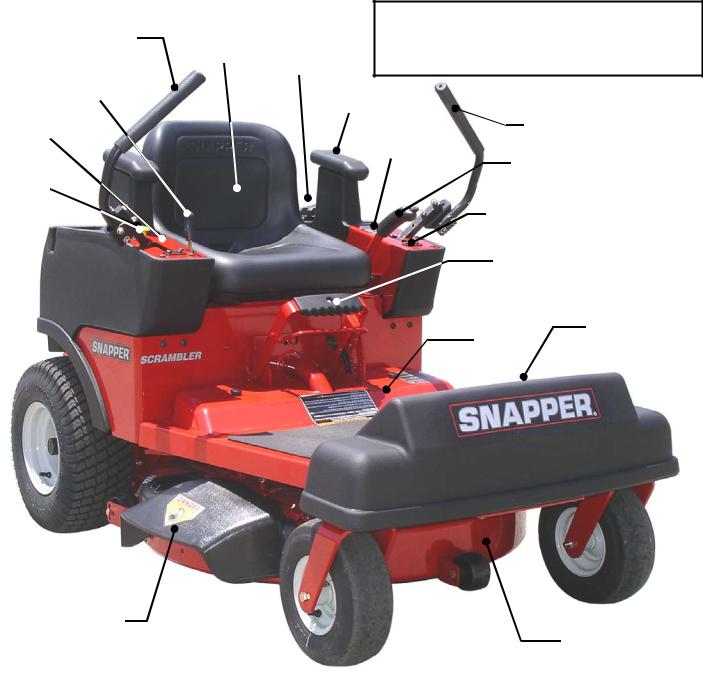
Section 1 - FAMILIARIZATION
RIGHT MOTION |
OPERATOR’S |
CONTROL LEVER |
SEAT |
ENGINE SPEED & |
FUEL TANK |
|
|
CHOKE CONTROL |
|
IMPORTANT! The figures and illustrations in this manual are provided for reference only and may differ from your specific model. Contact your Snapper dealer if you have questions.
|
ARM REST (2) |
|
RIGHT CONTROL |
|
LEFT MOTION |
PANEL |
IGNITION |
CONTROL LEVER |
|
SWITCH |
|
PARKING BLADE BRAKE SWITCH
LEFT CONTROL PANEL
CUTTING DECK HEIGHT
ADJUSTMENT HANDLE
FOOT
FLOOR REST
PAN
DECK DISCHARGE DEFLECTOR
CUTTING DECK
FIGURE 1.1
1.1 INTRODUCTION
This manual has been prepared for operators of the SNAPPER SCRAMBLER ZERO-TURN MOWER. Its purpose, aside from recommending standard operating procedures and routine service requirements, is to promote SAFETY through the use of accepted operating practices. Read, Understand and Follow the IMPORTANT SAFETY INSTRUCTIONS on Pages 2 - 4 of this manual and All SAFETY messages on the machine and its attachments before operating. SNAPPER recommends returning the machine to an authorized SNAPPER dealer annually for inspection and addition of any new devices, which might upgrade the safety of the mower.
1.2 NOMENCLATURE
The nomenclature drawing above, Figure 1.1, shows the essential parts of the machine. It is recommended that all operators of this equipment become thoroughly familiar with the controls, components, and operation of this machine before operating. Specific details involving the engine are found in the separate engine owner’s manual. Study these manuals before operating and keep both handy for future reference. For the nearest SNAPPER dealer in your area, check the yellow pages under the heading LAWN MOWERS. For engine parts and service, look for the engine manufacturer’s dealers under the heading, ENGINES - gasoline.
6
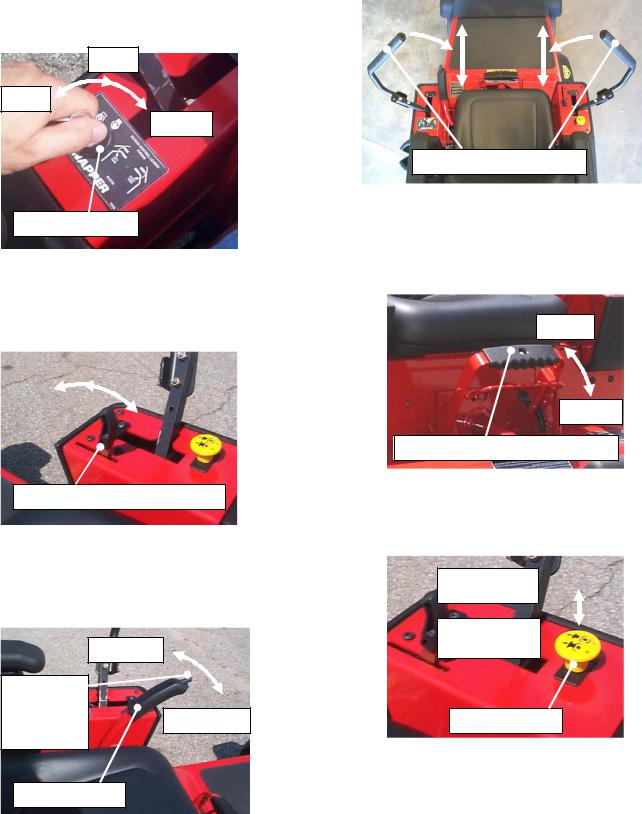
Section 1 - FAMILIARIZATION
1.3 BASIC CONTROLS AND THEIR FUNCTIONS
The figures below identify each of the operator controls and their basic function. Controls will be described in greater detail further on in this manual.
1.3.1. IGNITION SWITCH (Left Control Panel)
Starts and stops engine. Refer to Section “ENGINE OPERATION” for further details.
RUN
STOP
START
IGNITION SWITCH
FIGURE 1.2
1.3.2. ENGINE SPEED & CHOKE CONTROL (Right Control Panel)
Controls engine speed; built-in choke control past ‘Fast’ detent in throttle control.
|
|
FAST (DETENT) |
|
|
|
|
|
|
|
|
|
|
|
|
CHOKE |
|
|
SLOW |
|
|
|
|
|
|
ENGINE SPEED & CHOKE CONTROL
FIGURE 1.3
1.3.3. PARKING BRAKE (Next to Left Control Panel)
Applies park brake.
ENGAGE
DEPRESS
RELEASE
BUTTON TO
ENGAGE OR DISENGAGE
DISENGAGE
PARKING BRAKE
FIGURE 1.4
1.3.4. MOTION CONTROL LEVERS
Controls direction and steering of machine when driving. Refer to Section “MOTION CONTROL” for detailed operation of motion control levers.
MOTION CONTROL LEVERS
FIGURE 1.5
(Levers shown in Neutral Lock Position)
1.3.5. CUTTING DECK ADJUSTMENT HANDLE (Forward of Operator Seat)
Adjusts cutting deck height. Refer to Section “MOWER OPERATION” for further details.
RAISE
LOWER
CUTTING DECK ADJUSTMENT HANDLE
FIGURE 1.6
1.3.6. BLADE SWITCH (Right Control Panel)
Engages and disengages cutting blade(s). Refer to Section “MOWER OPERATION” for further details.
PULL OUT (‘I’)
TO ENGAGE
PUSH IN (‘0’)
TO DISENGAGE
BLADE SWITCH
FIGURE 1.7
7
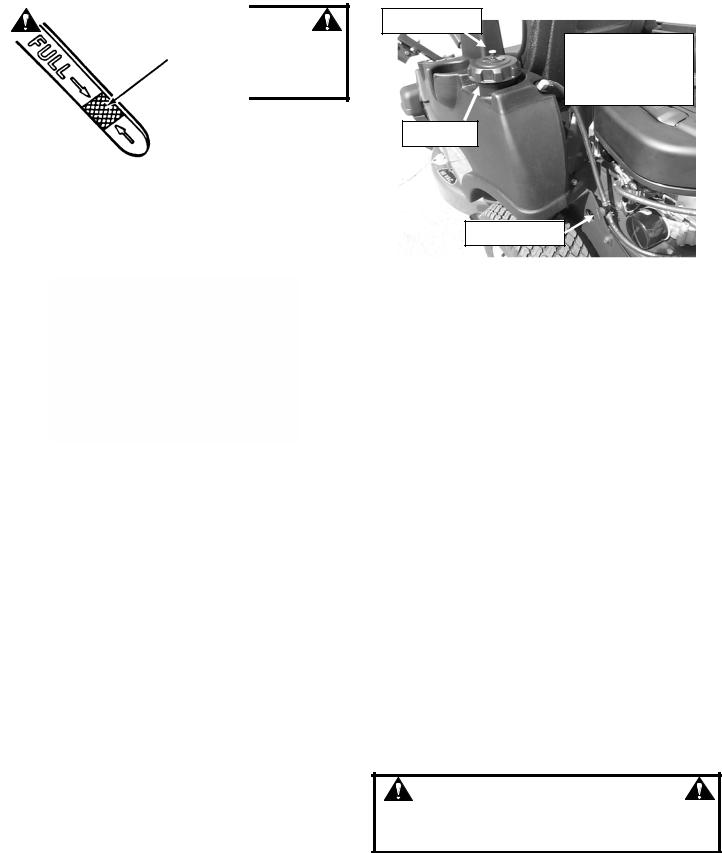
Section 2 - OPERATING INSTRUCTIONS
WARNING
DO NOT attempt to operate the machine until you have read this manual thoroughly and become familiar with all controls and operating procedures. Serious injury or damage can result.
2.1PRE-START CHECK LIST
Make the following checks and perform the service required before each start-up.
2.1.1.Check tires and add or release air as needed to bring pressure to 12 P.S.I. front and rear.
2.1.2.Check guards, deflectors and covers to make sure all are in place and securely tightened.
2.1.3.Check engine oil and add as needed to bring level up to the FULL mark. Refer to engine owner’s manual for oil specifications. See Figure 2.1.
ENGINE OIL DIPSTICK
SAFE LEVEL
AREA
FIGURE 2.1
2.1.4.Check all controls to make sure they operate freely and correctly. (Refer to section “FAMILIARIZATION”.)
2.1.5.Clean exterior surfaces of cutting deck and engine of any accumulation of dirt, grass, oil, etc. Keep engine air intake screen and cooling fins clear at all times.
2.1.6.Add fuel to tank with machine out of doors where fumes can safely dissipate. Refer to engine owner’s manual for fuel specifications. Make sure fuel filler cap is tight after filling tank. Open vent screw on fuel cap by turning counterclockwise. Also open fuel valve, located in fuel line. See Figure 2.2.
VENT SCREW
FUEL FILLER CAP
WITH VENT SCREW.
TIGHTEN CAP AND
OPEN VENT SCREW
AFTER REFUELING.
FUEL CAP
FUEL VALVE
FIGURE 2.2
2.2ENGINE OPERATION 2.2.1. STARTING ENGINE
1.Make sure both motion control levers are lifted fully up and out into their neutral lock positions. See Figure 1.5.
2.Make sure blade switch is pushed in to its off (‘0’) position. See Figure 1.7.
3.Make sure parking brake is engaged. See Figure 1.6.
IMPORTANT: Engine will not crank or start unless steps 1 thru 3 have been taken.
4.Make sure vent screw on fuel cap and fuel valve in fuel line are both open. See Figure 2.2. IMPORTANT: Failure to open vent screw and/or fuel valve will prevent engine from starting, or will cause engine to stall after starting.
5.Sit squarely in operator seat.
6.Move engine speed control fully forward to ‘Choke’ position. See Figure 1.3.
7.Turn key to “START” position and hold until engine starts. See Figure 1.2. NOTE: If engine does not start after 5 seconds, release key, wait 20 seconds, then attempt starting again. (If engine still fails to start, refer to the troubleshooting section of both mower and engine manuals.)
8.After engine starts, move engine speed control back past choke control and to desired speed position. Allow a brief warm-up until engine runs smooth.
WARNING
DO NOT leave machine with engine running. STOP engine. STOP blades. Engage park brake. Remove key. DO NOT park machine on slopes.
2.2.2. STOPPING ENGINE
1. Stop engine by turning key to “STOP” position. See Figure 1.2.
8

Section 2 - OPERATING INSTRUCTIONS
2.3MOTION CONTROL
IMPORTANT: This machine is equipped with hydrostatic drive. The direction and speed of movement are controlled by dual motion control levers. A small amount of movement of either lever may cause the machine to move instantly, and can result in severe injury or damage. Operate levers slowly and smoothly.
To safely develop driving skills, practice driving the machine with blades disengaged, engine speed at a slow setting, in an open area away from people and obstacles. (To safely roll the machine into an open area, refer to Section “ROLLING MACHINE MANUALLY”.)
2.3.1. GETTING READY
1.Sit squarely in the operator seat, with feet firmly on the footrest.
2.Be sure Blade Switch is pushed in to its off (‘0’) position. See Figure 1.7.
3.Start engine.
4.Disengage parking brake. See Figure 1.6.
5.Drop both motion control levers down and in toward the center of the machine, and rest elbows comfortably on armrests. See Figure 2.3.
5.DROP LEVERS
1. SIT SQUARELY IN SEAT
2. MAKE SURE |
3. START ENGINE |
BLADE SWITCH |
|
IS OFF (‘0’) |
4. DISENGAGE |
|
PARKING BRAKE |
|
FIGURE 2.3
2.3.2. FORWARD MOTION
Slowly and equally push both levers forward. See Figure 2.4. The farther you push, the faster the machine will go. (Machine speed can be further adjusted with the engine throttle control; return motion control levers to their neutral lock positions before adjusting engine throttle.)
DIRECTION
OF TRAVEL
FIGURE 2.4
NOTE: If, with equal pressure applied to both motion control levers, machine ‘tracks’ (veers) right or left, Refer to Section “MOTION CONTROL ADJUSTMENTS”.
2.3.3. REVERSE MOTION
Slowly and equally pull both levers toward the back of the machine. See Figure 2.5. Note that the machine travels much slower in full reverse than in full forward. Do not attempt adjustment of this important safety feature.
DIRECTION
OF TRAVEL
FIGURE 2.5
WARNING
DO NOT operate blades in reverse. STOP BLADES. LOOK and SEE behind and down for children, pets and hazards before and while backing.
9
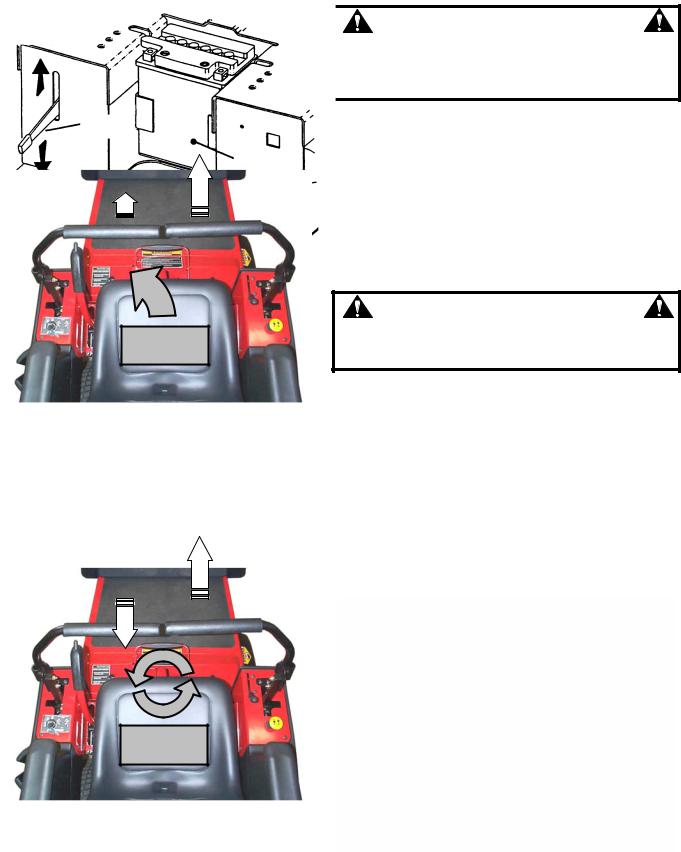
Section 2 - OPERATING INSTRUCTIONS
2.3.4. CONVENTIONAL TURNING
1.To turn left, slowly ease back on the left lever while keeping or increasing pressure on the right lever. See Figure 2.6. The more you ease off on the left lever and/or push on the right lever, the tighter the turn.
2.To turn right, slowly ease back on the right lever while keeping or increasing pressure on the left lever. The more you ease off on the right lever and/or push on the left lever, the tighter the turn.
DIRECTION
OF TRAVEL
FIGURE 2.6
(Left turn shown; right turn opposite)
2.3.5. ZERO-TURNING
1.To Zero-turn left, push the right lever forward while pulling the left lever back into reverse. See Figure 2.7.
2.To Zero-turn right, push the left lever forward while pulling the right lever back into reverse.
DIRECTION
OF TRAVEL
FIGURE 2.7
(Left zero-turn shown; right turn opposite)
WARNING
Zero-turning the machine at any speed can result in operator disorientation, or in operator being thrown from the machine. Exercise extreme caution when executing a zero-turn.
2.3.6.STOPPING MOTION
1.Return both motion control levers to neutral.
2.If driving is not to be resumed immediately, lift levers fully up and out into their neutral lock positions and engage parking brake.
IMPORTANT NOTE: Machine may not come to a complete stop immediately after returning to neutral, especially if machine is on even a slight incline. Always stop machine on level ground and engage parking brake.
WARNING
DO NOT leave machine with engine running. STOP engine. STOP blades. Engage park brake. Remove key. DO NOT park machine on slopes.
2.3.7. ROLLING MACHINE MANUALLY
To roll the machine without the engine running, pressure within the hydraulic pumps must be released. A control lever is located next to the battery compartment under the operator seat. Tilt the seat up and slide the lever down to release pressure and allow machine to roll freely. NOTE: Always return lever to “UP” position after rolling. See Figure 2.8.
DO NOT USE CONTROL TO COAST DOWN SLOPES. RELEASE PRESSURE ONLY WHEN ENGINE IS OFF AND MACHINEMOTIONCANBECONTROLLED.
SLIDE CONTROL
LEVER UP TO
DRIVE MACHINE
CONTROL
LEVER
BATTERY
SLIDE CONTROL LEVER
DOWN TO ROLL
MACHINE
FIGURE 2.8
10
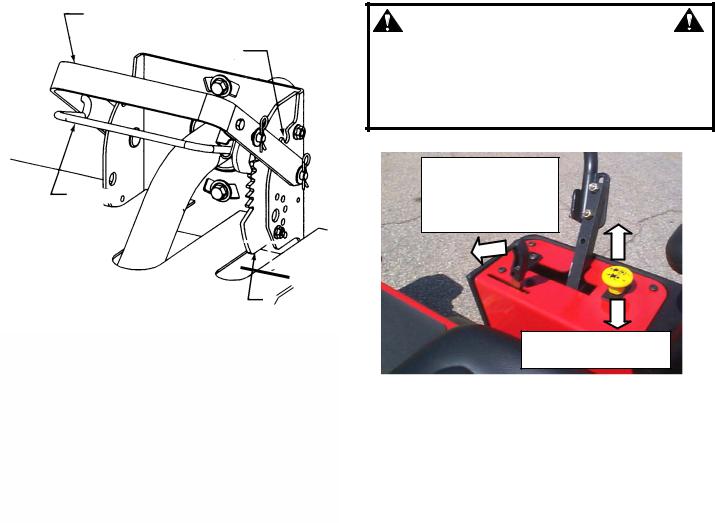
Section 2 - OPERATING INSTRUCTIONS
2.4 MOWER OPERATION
2.4.1. CUTTING HEIGHT ADJUSTMENT
This machine has seven different cutting height positions. IMPORTANT: When positioning the cutting deck into a higher cutting position, pull up on the deck lift handle only, it is not necessary to pull up on the release lever at the same time. Use the release lever when moving deck cutting height to a lower cutting position.
1.Grasp both handles together to disengage latch.
2.Raise or lower handles to desired height.
3. Release lower handle to engage latch. See Figure 2.9.
DECK LIFT
HANDLE
RELEASE
LEVER
CONNECTING BAR OMITTED
IN THIS VIEW FOR CLARITY DETENT PLATE
FIGURE 2.9
IMPORTANT: DO NOT adjust cutting deck with mower blades engaged. Be sure Blade Switch is off before adjusting deck.
2.4.1. MOWER BLADE ENGAGEMENT
1.With engine running, move engine speed control to the Rabbit or “fast” position detent. (Be careful not to slide farther than detent, or choke will engage and engine will stall.)
2.Pull Blade Switch out to its on (‘I’) position to engage mower blade. See Figure 2.10.
2.4.2. MOWING OPERATIONS
1.Please refer to the Important Safety Instructions at the beginning of this manual for instruction on safe mowing practices.
2.Refer to “MOTION CONTROL” earlier in this section to safely and effectively maneuver the machine during mowing operations.
2.4.3. MOWER BLADE DISENGAGEMENT
Push Blade Switch in to its off (‘0’) position to disengage mower blade(s). See Figure 2.10.
WARNING
Blades must stop rotating in 5 seconds or less after blade switch has been turned off. DO NOT operate machine unless blade brake is functioning properly. If adjustment or repair is necessary, refer to Section “Blade Brake Adjustment” or contact your SNAPPER dealer for assistance.
TO START BLADES,
MOVE ENGINE SPEED
CONTROL TO ‘FAST’
DETENT, THEN PULL
BLADE SWITCH OUT.
TO STOP BLADES, PUSH
BLADE SWITCH IN.
FIGURE 2.10
11
